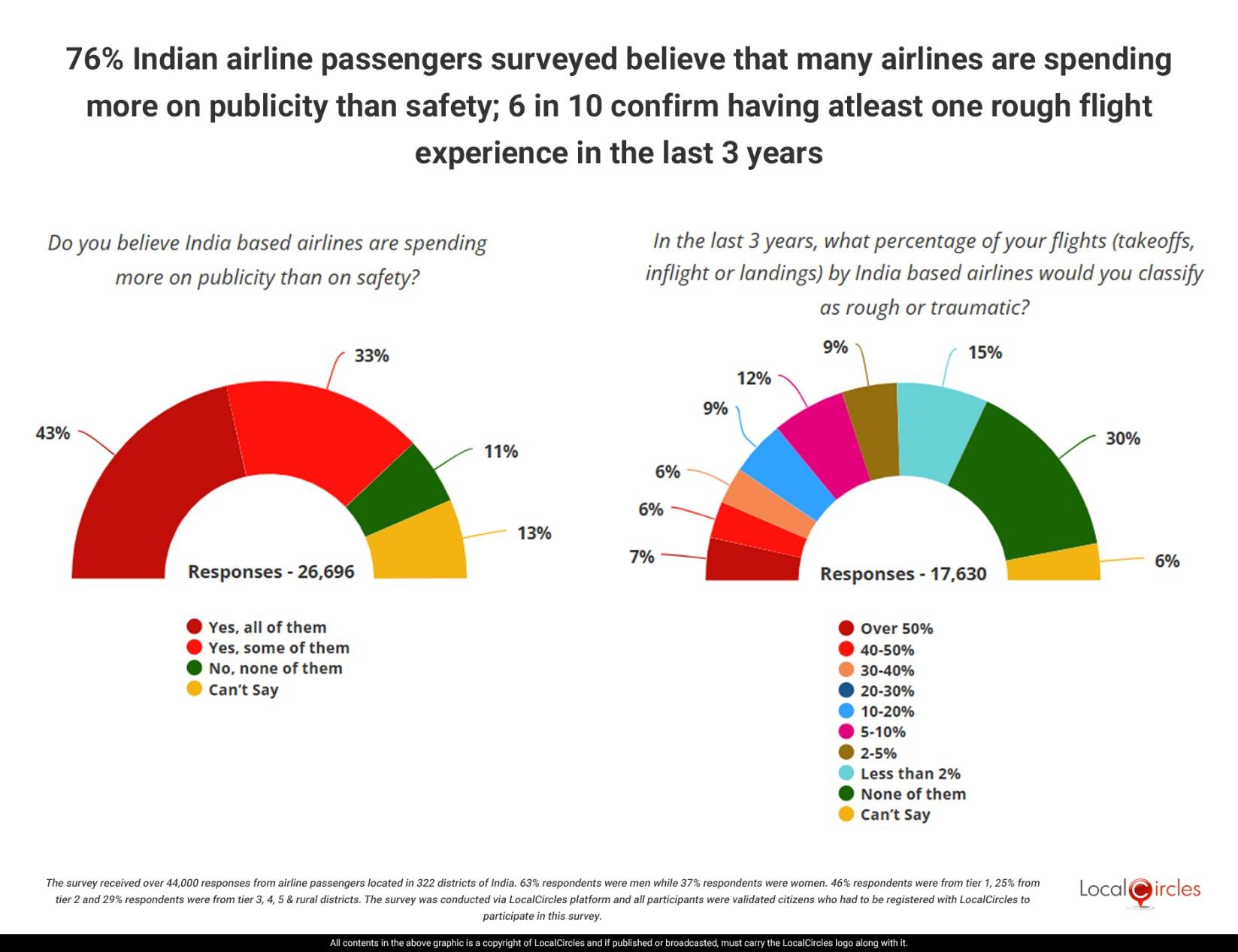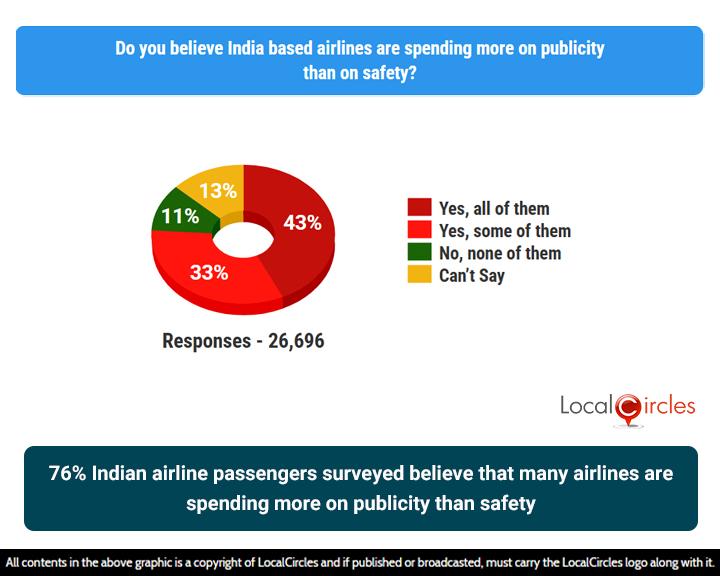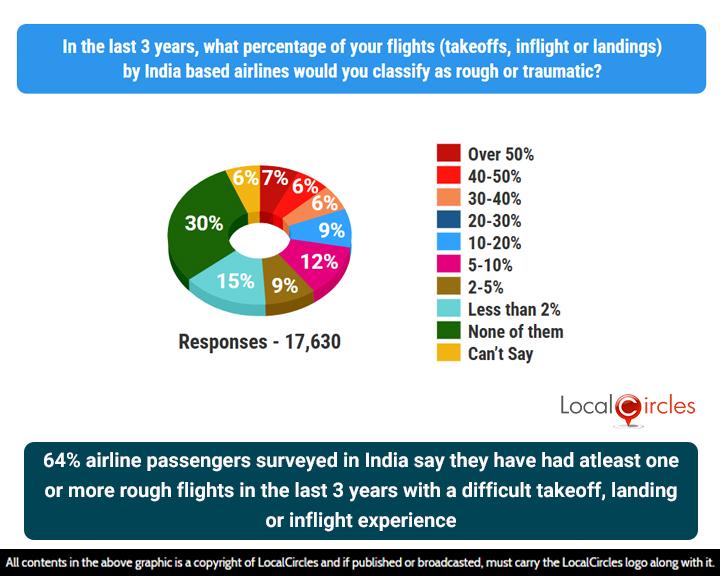76% Indian airline passengers surveyed believe that many airlines are spending more on publicity than safety; 6 in 10 confirm having at least one rough flight experience in the last 3 years
- ● Airline travellers deeply concerned about safety in a survey that received 44,000 responses from citizens located across 322 districts of India

July 24, 2025, New Delhi: Amidst monsoon rain yesterday, Air India flight AI 2744 from Kochi skidded off Mumbai’s primary runway upon landing. Three tyres burst, engine cowling and runway lights were damaged, and the aircraft veered into unpaved terrain before taxiing to gate. Though all passengers and crew disembarked safely and a DGCA probe was initiated, the incident made airline travellers nervous once again, some of whom are still tracking the probe findings from AI 171 crash in Ahmedabad last month, a few minutes post take off.
Speculation is rife even as investigators probe what led to the change in position of fuel switches to cutoff position in the Boeing 787 Dreamliner, which crashed in Ahmedabad soon after take-off on June 12 leading to the death of 260 people on board and on the ground, were turned off due to human error or plane systems failure. Either situation speaks poorly about the airline, in this case Air India, given that it is responsible for ensuring the health (maintenance) of the plane and the pilots.
Aviation regulator Directorate General of Civil Aviation (DGCA) recently issued directives for mandatory inspections and assessment of airworthiness of a range of Boeing's India-registered aircraft, engines and related components by July 21.”It has come to the notice of DGCA, that several operators--international as well as domestic--have initiated inspection on their aircraft fleet in accordance with the Special Airworthiness Information Bulletin NM-18-33, dated December 17, 2018," the aviation regulator wrote.
The US Federal Aviation Administration's December 2018 advisory had recommended that operators of several Boeing models, including the 787 Dreamliner, to inspect the locking feature of the fuel cutoff switches. The directive assumes significance as it follows a preliminary report by the Aircraft Accident Investigation Bureau (AAIB) into Air India's Boeing 787-8 crash in Ahmedabad on June 12, which killed 260 people on board and on ground, has raised questions over engine fuel cutoff switches.
AAIB is reported to have briefed Members of the Parliamentary Standing Committee on Transport, Tourism and Culture on the ongoing investigation into the Air India Boeing AI 171 crash, raising questions on the maintenance and safety of aircrafts.
Meanwhile, the Tata Group-owned Air India, and the DGCA are reported to have come under heavy fire from Opposition leaders at the Parliamentary panel meeting on aviation safety on July 9, with Air India being told to provide written replies on safety issues following the crash in Ahmedabad.
The DGCA has also faced tough questions, including on the shortage of personnel, with 45% of its sanctioned posts lying vacant, and questions raised on its autonomy, media reports state. Staff shortages at the DGCA needs to be addressed as the civil aviation sector is growing rapidly with the induction of more aircraft, and new airports in the country, members of the panel also said.
The Members of Parliament on the panel are also reported to have expressed concern about the overworked air traffic control personnel, stressing they were required to monitor nearly 30 flights simultaneously, whereas only eight to nine flights were guided at a time globally. The panel has demanded that the DGCA carry out a safety audit within three months (from the June 12 crash). The aviation regulator is reported to have stressed its constraints, resulting from a resource crunch. The DGCA has also been asked to explain what it was doing about multiple incidents of technical glitches in airplanes reported since the June 12 crash.
The PAC has also asked Air India why it continued to face consumer complaints on issues such as broken seats and poor air conditioning three years after privatization, and how long it would take to fix these problems.
During its recent detailed inspection at some of the leading airports, the DGCA had identified significant lapses in airport operations and aircraft maintenance procedures across several airlines and airport operators. These included delayed maintenance checks, improper record-keeping, insufficient ground staff training, and inadequate runway safety protocols. The findings raised concerns about passenger safety and regulatory compliance leading DGCA to issue strict directives to airlines and airport operators.
Airports have also been ordered to improve airside safety by enhancing runway surface inspections, lighting systems, and emergency response readiness. Additional directions include deploying more ground staff during peak hours, regular calibration of navigation aids, and better coordination with Air Traffic Control. They have warned of intensified surveillance, surprise audits, and possible penalties for non-compliance.
The scrutiny has been enhanced following incidents involving technical snags and operational delays. The aviation regulator reiterated its commitment to ensuring the highest standards of flight safety and operational discipline across India’s aviation ecosystem.
With thousands of comments received on airline safety in India since the AI 171 incident, LocalCircles through a new survey has strived to find out from fliers if safety is the top priority for airlines in India and their personal experiences in the last 3 years. The survey received over 44,000 responses from airline passengers located in 322 districts of India. 63% respondents were men while 37% respondents were women. 46% respondents were from tier 1, 25% from tier 2 and 29% respondents were from tier 3, 4, 5 & rural districts.
76% Indian airline passengers surveyed believe that many airlines are spending more on publicity than safety
The survey first asked air travelers, “Do you believe India based airlines are spending more on publicity than on safety?” Out of 26,696 who responded to the question 43% stated “yes, all of them”; 33% of respondents stated “yes, some of them”; 11% of respondents stated "no, none of them” focus more on publicity and less on safety; and 13% of respondents did not give a clear answer. To sum up, 76% Indian airline passengers surveyed believe that many airlines are spending more on publicity than safety.

64% airline passengers surveyed in India say they have had at least one or more rough flights in the last 3 years with a difficult takeoff, landing or inflight experience
In the light of reports of flight being diverted or returning to base due to technical or weather issues or flight getting aborted, the survey asked fliers, “In the last 3 years, what percentage of your flights (takeoff, inflight or landings) by India based airlines would you classify as rough or traumatic?” Out of 17,630 who responded to the question 75% stated “over 50%” of flights; 6% of respondents stated “40-50% flights; 6% of respondents stated "30-40%” flights; 9% of respondents stated "10-20%” flights; 12% of respondents stated "5-10%" flights; 9% of respondents stated "2-5%" flights; 15% of respondents stated "less than 2%” flights; 30% of respondents stated "none of them”; and 6% of respondents did not give a clear answer. To sum up, 64% airline passengers surveyed in India say they have had at least one or more rough flights in the last 3 years with a difficult takeoff, landing or inflight experience.

In summary, 76% Indian airline passengers surveyed believe that many airlines are spending more on publicity than safety, which appears not too surprising given the recent DGCA inspection findings. Almost two-third or 64% airline passengers surveyed in India say they have had at least one or more rough flights in the last 3 years with a difficult takeoff, landing or inflight experience.
As India strives to become a global business hub and tourist destination, it cannot afford to overlook or shortchange on aviation safety which depends on several factors including trained and alert pilots, proper aircraft maintenance, and a good airport infrastructure. The government needs to improve the strength of the DGCA so that it can fulfill its role as aviation regulator and thus ensure that no airline or airport overlooks safety protocol and proper operations.
Survey Demographics
The survey received over 44,000 responses from airline passengers located in 322 districts of India. 63% respondents were men while 37% respondents were women. 46% respondents were from tier 1, 25% from tier 2 and 29% respondents were from tier 3, 4, 5 & rural districts. The survey was conducted via LocalCircles platform, and all participants were validated citizens who had to be registered with LocalCircles to participate in this survey.
About LocalCircles
LocalCircles, India’s leading Community Social Media platform enables citizens and small businesses to escalate issues for policy and enforcement interventions and enables Government to make policies that are citizen and small business centric. LocalCircles is also India’s # 1 pollster on issues of governance, public and consumer interest. More about LocalCircles can be found on https://www.localcircles.com
For more queries - media@localcircles.com, +91-8585909866
All content in this report is a copyright of LocalCircles. Any reproduction or redistribution of the graphics or the data therein requires the LocalCircles logo to be carried along with it. In case any violation is observed LocalCircles reserves the right to take legal action.


